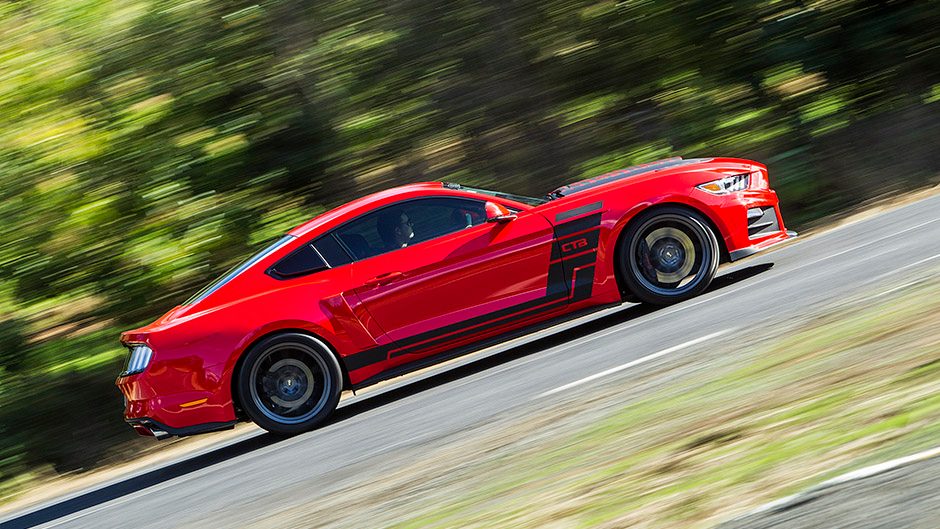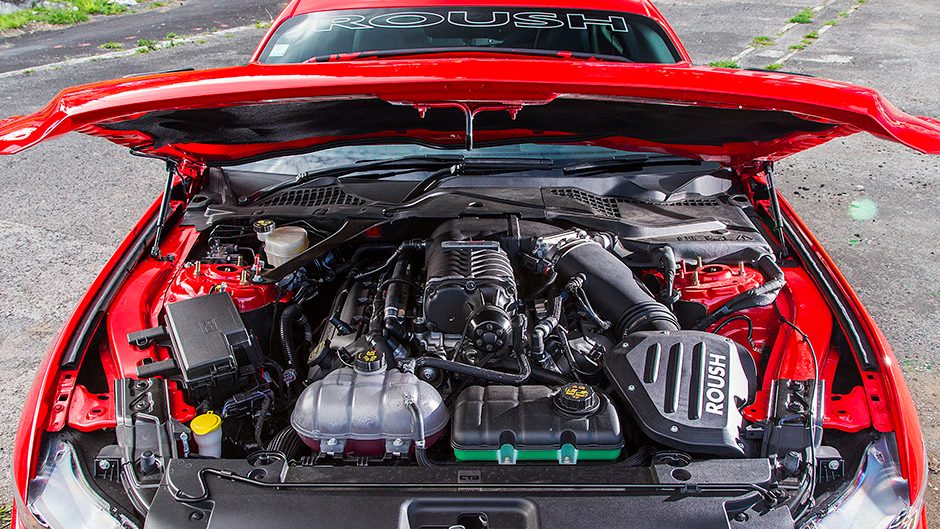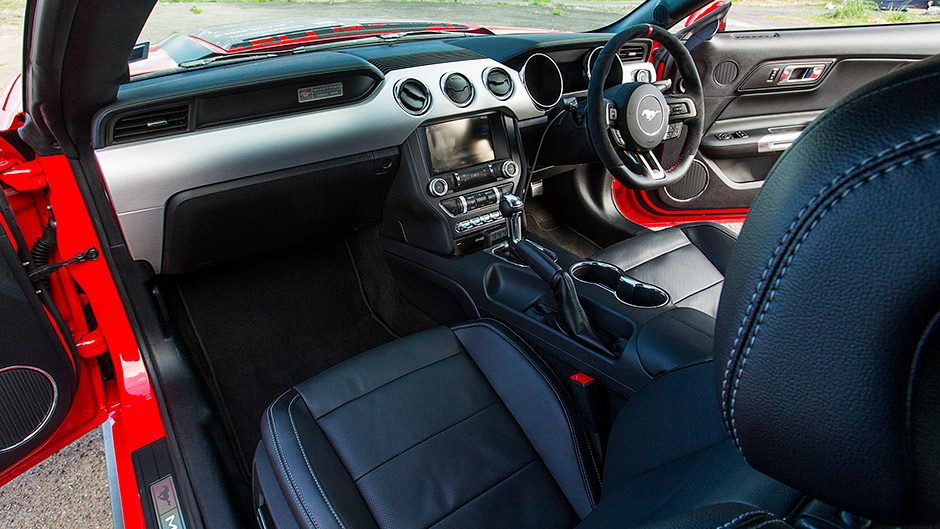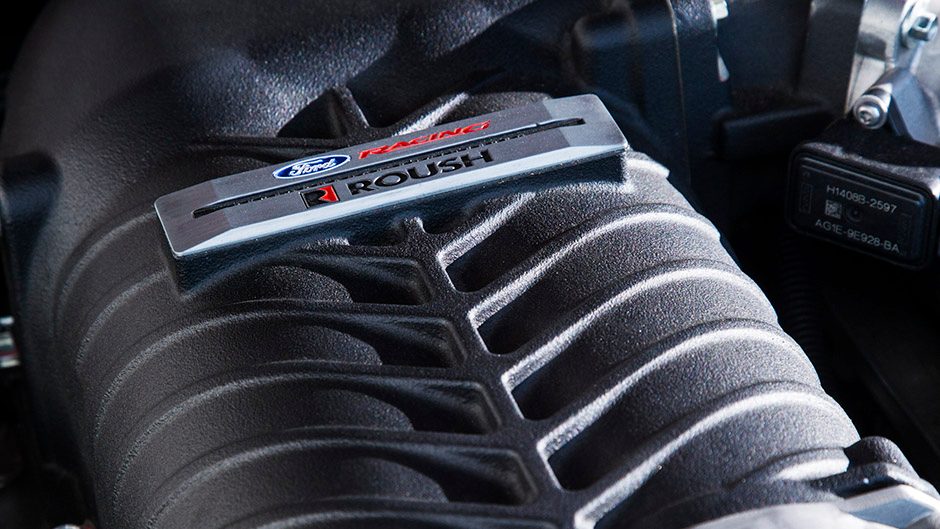They say the Ford Mustang is the most tuned car in the world. It helps that many of the old nags are in dire need of a good seeing to. And that Stateside you can pick up old mules for ‘chump change’ as they call it. There is a huge aftermarket industry looking after Mustang in its all of its generations, from complete restorations of the classics to pro-touring options sporting air suspension and the latest crate engines. There’s even a market for tuned Fox-body models, and even the horrid little Mustang II. If you can think it, there’s a tune-up option for every Mustang imaginable, particularly if you have drag racing in mind.
Enhancing the new Mustang is proving popular in New Zealand, with plenty of buyers opting to dip into the range of Ford Performance upgrades available through their local dealer at the time of purchase. This sees their Mustang delivered ready to go with a few more ponies and a lot more noise than the standard offering. For the GT model there are three upgrades available; Stage One adds a few more kilowatts and decibels thanks to an air box and muffler change. Stage Two bolts on a freer-flowing exhaust while an engine tune takes power to a quoted 360kW at the flywheel and would be the most logical upgrade as it costs a modest $9k with the muffler kit. And all with the factory warranty intact too.

For those looking to step things up a notch or three, there’s the Stage Three kit, adding a blower to take the kilowatt count to a claimed 500 while liberating $25k from the owner. This includes a supercharger kit, cat-back exhaust, new air box and engine tune, and you best go for the sport muffler kit while you’re at it. What’s another $2200 anyhow? We recently tested this package as fitted to CTB Performance’s show car, a GT auto, which has been treated to a full Roush kit.
First, the sound. The exhaust mods free the noise every V8 fan wants to hear, particularly at start-up and idle with a satisfying, even rumble. There’s no lumpiness here with the quad-cam configuration. There are a few speed zones where it will begin to drone but a quick downshift usually sorts that if it annoys. At 100km/h there’s not so much of a problem. As the engine hones in on 6000rpm, the note is raspy, loud and bellowing, though lacking the usual supercharger whine. You just don’t hear the blower at all but you do feel its presence. The supercharger fills the bottom end of the rev happy V8 with some much needed torque.
It’s not a sledgehammer, but rather the surge builds gradually. The in-gear pull is impressive as the speedo needle moves swiftly around its dial while the tacho needle hardly moves in the taller gears. And this helps even out fuel consumption from ridiculously ravenous when pumping away hard, to the usual mid- to high-teens average of the stock standard GT. This car is a daily driver and was showing a long term average of 19L/100km.

The power delivery is what you’d term interesting. It likes the throttle to be all the way open and then it spews out the grunt but on part openings, it can get cranky. This car had been fitted with a set of headers, not usually part of the Stage Three kit, and Sam from CTB Performance, the company which carries out the Ford Performance work, said this has exacerbated a slight hesitation with the Roush blower. He says he’s been meaning to tune it out on the dyno, but he’s been busy modifying other Mustangs. Every time we go out to CTB Performance, you can’t move for all the GTs in for hot ups, so we’ll forgive him on this occasion.
Given it likes to be driven flat out, it’s a bit of a handful on road as the opportunities to go hard are limited. But when you can, it delivers the rush that is missing from the stock GT experience. While there is more torque lower down, the engine still likes revs and the real power isn’t unlocked until at least 4000rpm. Once accessed, you’re really hauling. As we have noted with other supercharger conversions, the auto has its work cut out trying to keep up with the enhanced torque curve, while cog swaps at higher engine speeds are harsh. But with so much more shove, the ’box doesn’t have so many shifts to execute. In the stock GT, we were always looking to hook second gear to enable better drive out of the slower bends, but with this set-up it’s just not advisable. With the added grip of the wider 295 rear Pirellis that encase the new wheels, third gear hauls you out nicely, though a degree of throttle caution is still advisable.
No prizes for guessing – it was a prickly beast to performance test, even with that extra tread. Stalling it up on the brake is a pointless exercise unless you intend to vaporise the tyres. Those first few metres are the most vital, and so gently tipping the throttle in gets the Mustang moving before you squeeze the gas down gingerly. And it’s still struggling for traction as it squirms its way to a 4.3sec 0-100, with 80-120km/h taking 2.2sec. The gearing isn’t quite optimal for the latter, as it feels quicker than the number suggests, even if it is still struggling to ground the power. We reckon it’d have no problem breaking into the threes launching on warm tyres from a sticky staging area.

You may have noticed another feature of the CTB show car in the opening pic, its ride height. This GT is riding on air, the system replacing the regular dampers and springs with air bags. With some changes to a few of the linkages and sway bars, it allows for fully adjustable ride height ranging from slightly raised to sitting on the ground. There’s an air tank in the boot, positioned up behind the rear seats so as not to impact hugely on boot space (though the load through hole is useless, but we get the look is more important than the practicality) and a small compressor under the boot floor.
This is a little noisy in operation but it only works hard when you start playing around with the height, to be fair. So you get the low rider look when parked up, and then you can set your desired height for the drive. The system needs to be fool proof before it’s ready for general consumption however. As it rolls, if you have the wheels turned and lower it, the body will sink down and crush the guards, so this needs to be isolated. The price for the kit is likely to come in around the $10k mark, and CTB Performance is working on adapting the Camaro kit for use on the Commodore.

And what’s the actual ride like? It’s firmer than the stock GT set-up, for sure. While they aren’t adaptive air dampers, they remain surprisingly complaint as speeds rise. This helps improve the handling of the Mustang as it rids the suspension of its tendency to lean over before it heads into bends, and the steering still has its progressive feel as it nears the limit.
The Stage Three Roush kit adds $40k to the price of the GT as it includes the full Roush aero pack with its high air flow front end, splitter, lower driving lights, bonnet vents and scoop and other add-ons like the faux vents on the rear and the panels on the quarter windows, which look good but rob it of vision. The standard kit does not include the air ride but rather lowered springs and the Bathurst 20-inch wheels and Pirelli P Zeros.
As we said, there are plenty of options when it comes to souping up your Mustang and the full Stage Three kit is at the crazy end of the scale. It’s a tad stroppy for the road but would be great fun at the strip, and on the skid pan. Like a proper muscle car then.


